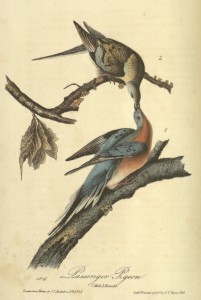The Long S, Now Largely Extinct
We had the opportunity last week to page through two volumes of our copy of Audubon’s double-elephant folio Birds of America with a small group of Friends of the UW-Madison Libraries and other enthusiasts of birds, books, or both. The two of us who were turning the pages of volume one (and it is definitely a two-person task) knew that plate 62, depicting the by now long extinct passenger pigeon, would draw particular attention. But once we looked more closely at the few words engraved on that particular plate, we were struck as well by the use of the long s in the word passenger.

Reproduced here is a detail from the handsomely digitized version “Audubon’s Birds of America at the University of Pittsburgh” that shows clearly the long s in the word passenger, in a label mimicking handwriting but as rendered by an engraver’s tool. Although this was a comparatively late example of the long s, it turns out that Audubon’s (or his engraver’s) use of the long s was fairly consistent, at least when a double s was involved. Witness the labels for the following:
- Grass-Finch, or Bay-winged Bunting (plate 94), engraved by R. Havell
- Mississippi Kite, with a long s in each pair of s’s (plate 117), engraved by R. Havell
- Tennessee Warbler (plate 154), engraved by R. Havell, plate dated 1832
- Nuttall’s lesser-marsh Wren (plate 175) engraved by R. Havell, plate dated 1833
- American Crossbill (plate 197) engraved by R. Havell, plate dated 1834
- Wood Ibiss – yes, spelled with a double s (plate 216), engraved by R. Havell, plate dated 1834
- White-ringed Crossbill (plate 364), engraved by R. Havell, plate dated 1837
- Glossy Ibis – here with both a long and short s in the word glossy but only one s in the word ibis (plate 387), engraved by R. Havell, plate dated 1837.
But there were exceptions – notably, the plates for the
- Lesser Tern (plate 319), engraved by R. Havell, plate dated 1836, and
- Lesser Red-Poll (plate 375), engraved by R. Havell, plate dated 1837
both abandoned the long s.

Certainly, by the publication of the more affordable The birds of America, from drawings made in the United States and their territories, 1st octavo edition (New York: J.J. Audubon; Philadelphia, J.B. Chevalier, 1840-1844), both the letterpress text and the hand-colored lithographed plates abandoned the long s. Witness the illustration on the left (from a page only 25 cm. tall) derived from the original Audubon drawing and the plate in the double-elephant folio (the pages in the latter are 100 cm. tall). The label under the image reads “Passenger Pigeon. 1. Male 2. Female. Drawn from Nature by J. J. Audubon F.R.S. F.L.S. Lith.d [lithographed] Printed & Col.d [colored] by J. T. Bowen Phil. [Philadelphia].” No long s here.
Of late we have been showing many 18th- and early 19th-century books to classes in a variety of subjects, from art history to history of science and beyond. The titles shown have ranged from perspective and optics to glass-making, from encyclopedias to zoology (see the entry for moss in the supplement to Chambers’ Cyclopaedia, or Donovan’s illustration of Belladonna’s butterfly).

As always, students ask about what looks to them to be an f where an s should be. We always ask them to see if in fact the letter in question has a full crossbar, and this opens up for discussion the topic of changes in letterforms and persistence of manuscript conventions in printed texts.
![Plate XXXV, Belladonna’s butterfly, from vol. 1 (1834) of Edward Donovan’s The naturalist’s repository, or, Miscellany of exotic natural history, 5 vols. (London: Printed for the author, and Simpkin & Marshall, 1834). From the Thordarson Collection, Department of Special Collections, Memorial Library, University of Wisconsin-Madison. Note the credit in the plate to "Mess.rs [Messieurs] Simpkin & Marshall."](https://cms.library.wisc.edu/specialcollections/wp-content/uploads/sites/17/2015/10/Donovan-belladonna_s-butterfly-plate-XXXV-178x300.jpg)
Note the credit in the plate to “Mess.rs [Messieurs] Simpkin & Marshall” — another instance of the long s.
Conventional wisdom, experience with printed books from the late 18th and early 19th centuries, and scholarship in history of print culture suggest that the long s disappeared in typeset text as other developments, including so-called modern typefaces, letterpresses with steel rather than wooden beds, orthographic shifts, and paper-making machines helped change the face of the page in printed books. Karen Attar offers a brief account, “S and long S,” in the Oxford companion to the book, ed. Michael Felix Suarez and H. R. Woudhuysen (2010), vol. 2, p. 1116, in the Special Collections reference holdings. Much more detail is available in Paul W. Nash, “The abandonment of the long s in Britain in 1800,” Journal of the Printing Historical Society, new series 3 (2001), 3–19, from the Memorial Library stacks. Nash sees the shift to the uniformly short s as occurring around 1800 in Britain, though he points to reasons — economic or cranky — why printers might have resisted casting off old styles and discarding old type just to jettison the long s. (Nash also addresses in a footnote some practices for rendering the letter s in intaglio plates, although he concentrates on plates engraved in Rome in this matter.) The topic has even engendered a Wikipedia entry of some length.
— Robin Rider